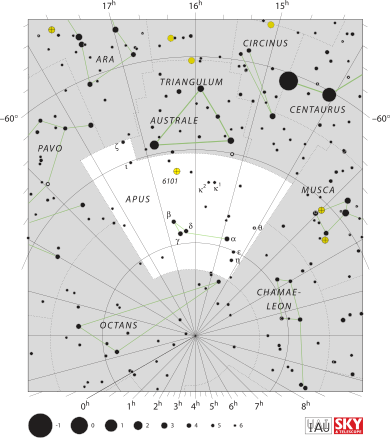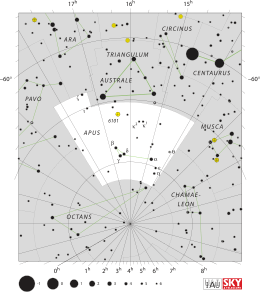Apus facts for kids
| Constellation | |

|
|
| Abbreviation | Aps |
|---|---|
| Genitive | Apodis |
| Pronunciation | genitive |
| Symbolism | The Bird-of-Paradise |
| Right ascension | 16 |
| Declination | −75 |
| Quadrant | SQ3 |
| Area | 206 sq. deg. (67th) |
| Main stars | 4 |
| Bayer/Flamsteed stars |
12 |
| Stars with planets | 2 |
| Stars brighter than 3.00m | 0 |
| Stars within 10.00 pc (32.62 ly) | 0 |
| Brightest star | α Aps (3.83m) |
| Messier objects | None |
| Meteor showers | None |
| Bordering constellations |
Triangulum Australe Circinus Musca Chamaeleon Octans Pavo Ara |
| Visible at latitudes between +5° and −90°. Best visible at 21:00 (9 p.m.) during the month of July. |
|
Apus is a constellation in the southern sky. It is hard to see because it is not very bright. Apus means "no feet" in Greek. It was named "no feet" because it looks like a Bird-of-Paradise, and people used to think that birds-of-paradise did not have feet.
Images for kids
-
Detail of Johann Bayer's 1603 Uranometria, showing the constellations Apus, Chamaeleon, Musca (as "Apis", the Bee), and Triangulum Australe, as well as the South celestial pole.
-
Globular cluster IC 4499 taken by Hubble Space Telescope.
See also
 In Spanish: Apus para niños
In Spanish: Apus para niños

All content from Kiddle encyclopedia articles (including the article images and facts) can be freely used under Attribution-ShareAlike license, unless stated otherwise. Cite this article:
Apus Facts for Kids. Kiddle Encyclopedia.



